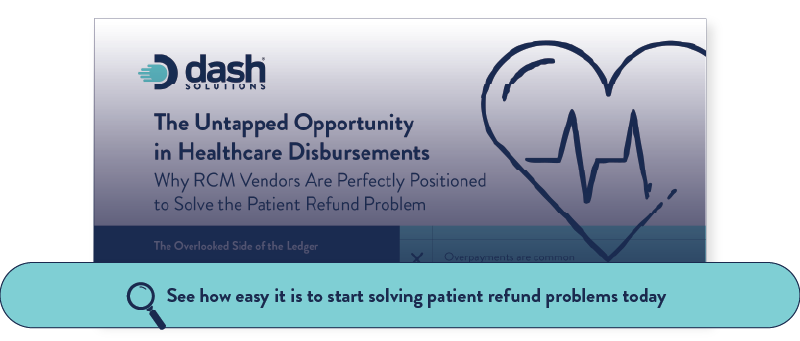Patient expectations are shifting in healthcare, prompted by digital-first expectations and the desire for seamless experiences. Still, the industry has been slow to accommodate in some instances, leading to patient frustration. For example, a recent JP Morgan study found that 44% of consumers cite slow refunds as the most frustrating part of their healthcare experience. In a competitive market, where patients have options and expect digital-first experiences, clinging to antiquated refund methods is not just bad practice—it’s a strategic liability.
In healthcare finance, the spotlight has long been fixed on inbound payments: collecting co-pays, deductibles, and insurance reimbursements. For Revenue Cycle Management (RCM) organizations, these tasks are complex and critically important. But on the other side of the ledger, outbound payments to patients remain a stubborn source of friction. Patient refunds are often issued via paper checks or outdated credit workflows, creating delays, administrative burden, and frustrating experiences for patients. These inefficiencies strain internal resources and miss an opportunity to build trust and satisfaction at a critical point in the patient journey.
The Problem No One Wants to Own
In reality, patient refunds are anything but simple. Overpayments occur frequently due to changing insurance calculations, duplicate payments, or simple administrative errors. When overpayments happen, RCM vendors typically do what they’ve always done: generate a file of overpaid accounts and shift the responsibility back to the provider—or, in some cases, manage the refund process on the provider’s behalf. In either case, what follows is a slow, error-prone process of cutting checks, licking stamps, and hoping the right patient gets their money… eventually.
It’s inefficient. It’s expensive. And in today’s digital-first, consumer-driven world, it’s increasingly unacceptable.
RCM Vendors Are Already the Ledger of Record
Traditional check-based refunds create high processing costs, long delays, and compliance and fraud risks. What’s more, they lead to fragmented customer experiences and increased support inquiries. Still, revenue cycle management vendors are perfectly positioned to streamline patient refunds as a value add for their clients. They have visibility into the entire financial lifecycle of the patient, from insurance reimbursements to service charges and co-pays collected. If anyone knows when an overpayment has occurred—and to whom the money belongs—it’s the healthcare RCM vendor.
With the right technology partner, refund disbursements can be seamlessly embedded into existing workflows, enabling RCM vendors to automate patient refunds—and cut out checks—just as efficiently as they manage collections.

The Risk of Doing Nothing
For providers, the cost of doing nothing is climbing fast. Processing a paper check costs more than $7 per transaction, not to mention the administrative overhead and risk of fraud, now a $24 billion industry, according to a recent fraud survey. But the real danger is reputational.
PYMNTS data underscores the stark shift in patient expectations: while just 39% of patients preferred instant healthcare disbursements in 2023, that number nearly doubled (77%) in 2024. The sharp uptick is likely to continue in the digital-first era.
This sharp rise doesn’t just highlight the growing demand for quicker, more transparent financial transactions in healthcare; it spotlights a major compliance issue. Refund delays can raise red flags with auditors, damage accreditation, and even lead to financial penalties. Providers must solve this problem, and RCM vendors are well-positioned to help them.
RCM Vendors: From Trusted Payee to Trusted Payor
Forward-thinking RCM vendors are beginning to see the opportunity for a better, more valuable way to manage patient payments—one that enables healthcare RCM vendors to deliver funds in real-time, on a provider’s behalf, with context to their patients.
With embedded technology like Dash Solutions’ proven solution—Dash Digital with SpendIT SendIT™—RCM vendors can finally hit the “easy button” on patient refunds. Instead of shuffling files or pushing the burden onto providers to issue checks, revenue cycle management vendors can serve as the vital bridge, enabling instant or near-instant refunds through a flexible, patient-friendly experience. Refunds can be delivered via a digital card available for immediate online use, which can also be added to a digital wallet for in-person transactions. Patients can choose to transfer the funds—either partially or in full—to external accounts, including bank accounts, debit cards, Venmo, or PayPal. The RCM vendor can manage the refund as part of the same ledger where the original overpayment was identified.
This creates a triple win. Patients get a better experience, providers offload a burdensome task, and healthcare RCM vendors deepen their value proposition, becoming more indispensable partners to their clients.
A Strategic Shift for Revenue Cycle Management Vendors
Imagine being the RCM vendor that not only drives collections but also simplifies refunds—delivering compliance assurance, cost savings, and a better patient experience in one integrated package. That’s value, stickiness, and a model that shifts the market.
This is more than a feature; it’s a competitive differentiator. In a crowded market where RCM vendor firms are all calling on the same health systems, the ability to offer integrated disbursement capabilities is a powerful way to stand out.
RCM vendors that partner with payments organizations like Dash Solutions and leverage technology like Dash Digital with SpendIT SendIT can deliver real-time, compliant, and consumer-friendly refunds at scale without straying from their core competency. Providers can finally move beyond their legacy processes without adding complexity to their own workflows.
The Time Is Now
RCM vendors have a unique window of opportunity. Healthcare providers are under immense pressure to reduce costs and improve patient satisfaction, all while navigating razor-thin margins and increasing regulatory scrutiny. Solving the patient refund problem is no longer optional; it’s essential.
RCM vendors that seize this moment will not only solve a longstanding pain point for their clients but will also elevate their own position in the healthcare value chain. Those that don’t? They risk being outpaced by more agile, tech-enabled competitors.
The choice is clear: simplify both inbound and outbound patient payments and become a comprehensive financial partner to your clients. The opportunity is real, and the first movers will win.



